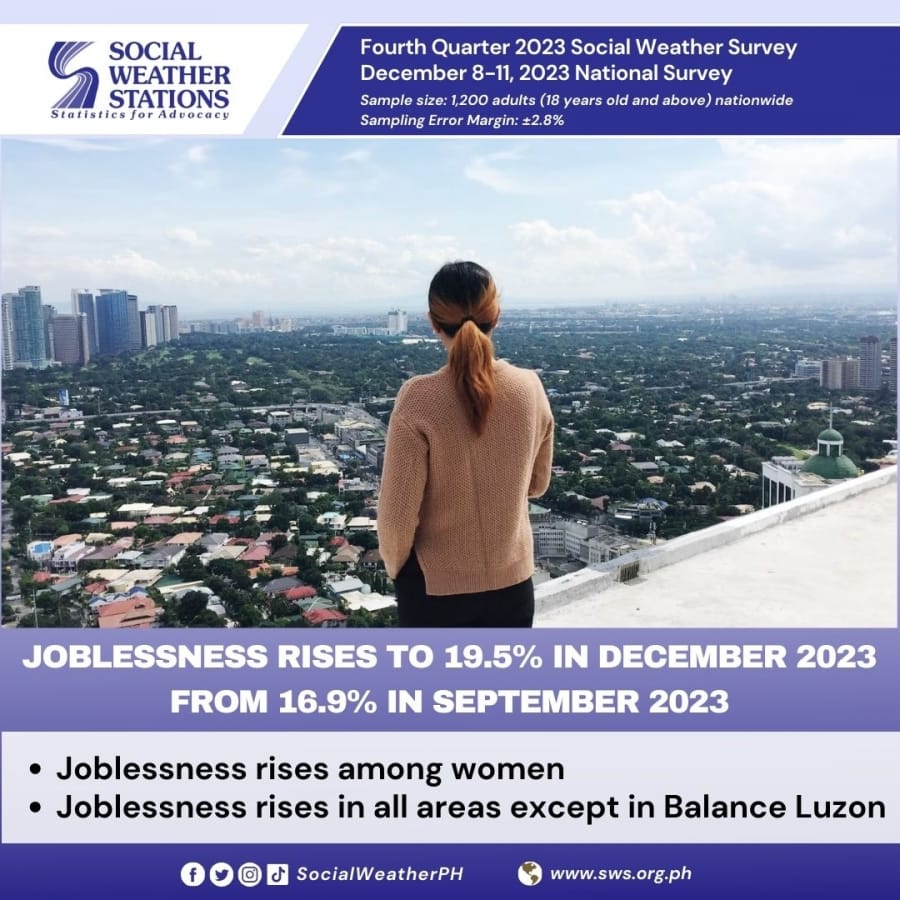
by Social Weather Stations
- Joblessness rises among women
- Joblessness rises in all areas except in Balance Luzon
The national Social Weather Survey of December 8-11, 2023, the most recent quarterly survey finalized by SWS, found joblessness at 19.5% of the adult labor force.
This was 2.6 points above the 16.9% in September 2023, but 3.3 points below the 22.8% in June 2023 [Chart 1, Table 1].
The resulting 19.6% average for 2023 was 2.1 points below the 21.7% average for 2022 and 6.1 points below the 25.7% average for 2021. It was similar to the 19.8% average of 2019, before the Covid-19 pandemic.
The estimated number of jobless people was 9.4 million in December 2023 and 7.9 million in September 2023.
SWS defines the Labor Force as adults (18 years and above) presently with a job plus those looking for a job. The Labor Force Participation Rate is the proportion of adults in the labor force.
The December 2023 survey found the Labor Force Participation Rate at 65.7%, or an estimated 48.3 million. It was 63.3%, or an estimated 46.5 million, in September 2023.
The jobless consist of those who (a) voluntarily left their old jobs, (b) are seeking jobs for the first time, or (c) lost their jobs due to economic circumstances beyond their control.
Joblessness reached a catastrophic level of 45.5% in July 2020 before going on a generally downward trend since September 2020.
Joblessness rises among women
As of December 2023, joblessness stayed higher among women at 26.0% than among men at 15.0% [Chart 2, Table 2].
Compared to September 2023, joblessness rose from 21.1% among women, while it hardly changed from 14.0% among men.
Joblessness rises in all areas except in Balance Luzon
As of December 2023, adult joblessness was highest in Metro Manila at 23.2%, followed by Balance Luzon at 21.0%, the Visayas at 18.0%, and Mindanao at 15.6% [Chart 3, Table 3].
Compared to September 2023, the quarterly joblessness fell from 19.2% in Metro Manila, 12.2% in the Visayas, and 12.4% in Mindanao. However, it hardly moved from 20.8% in Balance Luzon.
Incidence of Hunger rises among families of jobless adults
The December 2023 survey found that 12.6% of Filipino families experienced involuntary hunger – being hungry and not having anything to eat – at least once in the past three months ("SOCIAL WEATHER REPORT | Hunger rises from 9.8% in September to 12.6% in December 2023," January 22, 2024, www.sws.org.ph).
The incidence of involuntary hunger was twice as high among families of jobless adults than among families of those with a job/livelihood [Chart 4].
Involuntary hunger was 21.3% (consisting of 20.4% moderate hunger and 1.0% severe hunger, correctly rounded) among families of the jobless, compared to 10.9% (consisting of 9.5% moderate hunger and 1.4% severe hunger) among families of respondents with a job/livelihood.
Compared to September 2023, involuntary hunger rose from 17.7% (consisting of 14.6% moderate hunger and 3.1% severe hunger) among families of the jobless, and from 8.6% (consisting of 8.0% moderate hunger and 0.6% severe hunger) among families of respondents with a job/livelihood.
Joblessness rises among the 18-24-year-olds and 35-44-year-olds
As of December 2023, joblessness was highest among the 18-to-24-year-olds at 53.7%, followed by the 35-to-44-year-olds at 20.9%, the 25-to-34-year-olds at 19.1%, and those 45 years old and above at 12.8% [Chart 5, Table 4].
Compared to September 2023, joblessness rose from 34.4% among the 18-to-24-year-olds and 16.5% among the 35-to-44-year-olds. However, it fell slightly from 22.7% among the 25-to-34-year-olds, while it hardly changed from 11.9 % among those 45 years old and above.
Joblessness rises in both urban and rural areas
The December 2023 survey found adult joblessness slightly higher in urban areas at 21.2% than in rural areas at 17.8% [Chart 6, Table 5]
Compared to September 2023, joblessness rose from 18.0% in urban areas and 15.7% in rural areas.
The resulting urban-rural joblessness gap rose slightly from 2.3 points in September 2023 to 3.4 points in December 2023. The urban-rural joblessness gap was double-digit in only 10 out of 120 surveys since September 1993.
Joblessness rises in all educational groups except among college graduates
The December 2023 survey found adult joblessness to be highest among college graduates at 22.1%, followed by junior high school graduates at 20.8%, elementary graduates at 20.3%, and non-elementary graduates at 8.7% [Chart 7, Table 6].
Compared to September 2023, joblessness rose from 19.1% among junior high school graduates, 14.5% among elementary graduates, and 3.1% among non-elementary graduates. However, it fell slightly from 25.6% among college graduates.
SWS Joblessness is more comparable to PSA's combined Unemployment and Underemployment as a proportion of the Labor Force
In the past, SWS has compared its Joblessness rate with Philippine Statistics Authority's (PSA) Unemployment rate. However, given the differences between SWS and PSA's definitions of employment (e.g., age range, reference period, etc.), there has been an understandably large discrepancy between PSA's Unemployment rate and SWS's Joblessness rate. For example, SWS directly asks if the respondent has work at present, whereas PSA specifies a minimum of one hour of work to be counted as employed. The leniency of this requirement made it very easy to be officially categorized as employed.
To address this, PSA's Unemployment and Underemployment rates have been combined and expressed as a proportion of the Labor Force. The resulting statistic allows for more conceptually and statistically comparable rates with SWS's Joblessness rates, as it combines PSA respondents who are unemployed and those who have worked more than one hour in the past week who want more hours of work. This yields a more accurate picture of the labor situation in the Philippines.
To get the rate of the Underemployed as a proportion of the Labor Force, the rate of Unemployed is subtracted from the total Labor Force. The result, the rate of the Employed as a proportion of the Labor Force, is multiplied by the rate of Underemployed. The result is the rate of the Underemployed expressed as a proportion of the Labor Force.
When added to the rate of the Unemployed, this results in the PSA Combined Unemployment and Underemployment rate. This proportion is more comparable to the SWS data on Joblessness.
Survey background
The Fourth Quarter 2023 Social Weather Survey was conducted from December 8 to 11, 2023, using face-to-face interviews of 1,200 adults (18 years old and above) nationwide: 300 each in Metro Manila, Balance Luzon (or Luzon outside Metro Manila), the Visayas, and Mindanao. Face-to-face is the standard interviewing method for Social Weather Stations; the only exceptions were early in the pandemic when movement restrictions made face-to-face impossible and mobile phone interviews were conducted. Normal face-to-face field operations resumed in November 2020. The sampling error margins are ±2.8% for national percentages, and ±5.7% each for Metro Manila, Balance Luzon, the Visayas, and Mindanao.
The area estimates were weighted by the Philippine Statistics Authority medium-population projections for 2023 to obtain the national estimates.
The survey items reported here are non-commissioned. They are included on SWS's initiative and released as a public service.
The exact phrasing of the survey questions (the source language is Filipino; English translation included) was:
Joblessness. “Kayo po ba ay may trabaho sa kasalukuyan, walang trabaho ngayon pero mayroon dati, o hindi pa nagkaroon ng trabaho kahit minsan? [Do you have a job at present, not have a job at present but used to have a job, or never had a job?]
“IF NO JOB: Kayo po ba ay naghahanap ng trabaho o nagbabalak magtayo ng negosyo, o hindi? OO o HINDI [Are you looking for a job or planning to establish a business or not? YES or NO]”
Hunger. “Nitong nakaraang tatlong buwan, nangyari po ba kahit minsan na ang inyong pamilya ay nakaranas ng gutom at wala kayong makain? (OO, HINDI) [In the last three months, did it happen even once that your family experienced hunger and not have anything to eat? (YES, NO)]. “IF EXPERIENCED HUNGER: Nangyari po ba ‘yan ng MINSAN LAMANG, MGA ILANG BESES, MADALAS, o PALAGI? [Did it happen ONLY ONCE, A FEW TIMES, OFTEN, or ALWAYS?]”
Moderate Hunger refers to those who experienced hunger "Only Once" or "A Few Times" in the last three months, while Severe Hunger refers to those who experienced it "Often" or "Always" in the last three months.
SWS employs its own staff for questionnaire design, sampling, fieldwork, data processing, and analysis and does not outsource any of its survey operations. The report was prepared by Leo S. Laroza.
Chart 1
Chart 2
Chart 3
Chart 4
Chart 5
Chart 6
Chart 7
Table 1
Table 2
Table 3
Table 4
Table 5
Table 6
If you liked what you just read and want more of Our Brew, subscribe to get notified. Just enter your email below.


Related Posts
Social Weather Report | 59% Knew of VP Sara Duterte’s Fourth Impeachment Case Before the Survey; 41% Learned Only During the Interview
Jul 09, 2025
Supreme Court Rules Trump Can Rapidly Deport Immigrants to Libya, South Sudan and Other Countries They Aren’t From
Jun 25, 2025
Israel, Iran and the US: Why 2025 is a Turning Point for the International Order
Jun 19, 2025